The alternate image of Gyeongju is that of a trendy urban destination where contemporary culture and modern attractions seamlessly merge with tradition. Atmospheric cafés, fancy boutiques, scenic night views, and thrilling entertainment options attract a steady stream of young visitors.
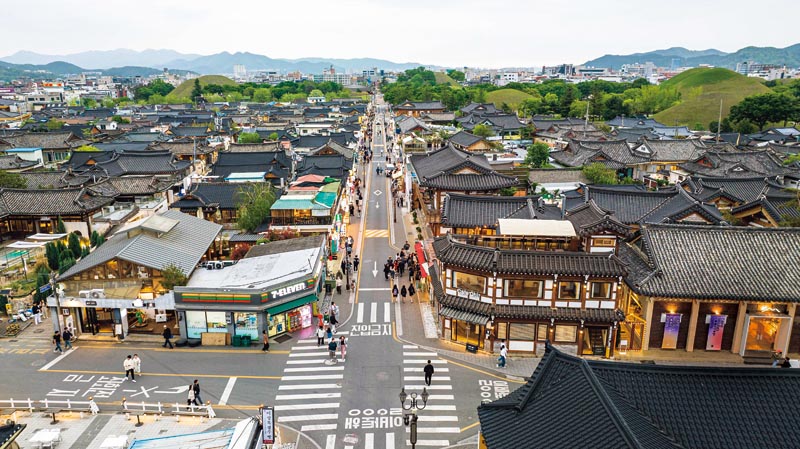
The vibrant neighborhood around Hwangnidan-gil allows visitors to experience both Gyeongju's historic ambiance and trendy atmosphere, making it the epicenter of the city’s tourism routes. The area boasts numerous stylish cafés and restaurants, drawing crowds of young people during weekends.
© Korea Tourism Organization
Hwangnam-dong, located in the southern part of Gyeongju’s historic center, is dotted with ancient burial sites. This area belongs to the Tumuli Park Belt, where royal tombs of kings, queens, and nobles of the Silla period (57 BCE–935 CE) are concentrated. It is part of the Gyeongju Historic Areas, a UNESCO World Heritage Site, and nearby are Gyerim, the forest said to be the birthplace of the Gyeongju Kim clan’s founder; Wolseong, a ruined Silla palace site; and a hanok village, consisting of traditional Korean homes.
Placed under strict construction regulations, Hwangnam-dong was preserved for many years but eventually became too shabby and run-down to ignore. Today, the neighborhood has a new look, both modern and retro, that is encapsulated in Hwangnidan-gil. Once an ordinary road, its re-purposed hanok and array of shops have turned it into a must-visit destination.
This February, the Gyeongju City government recorded approximately 540,000 tourists during the Lunar New Year holidays. A vivid showcase of Gyeongju’s latest trends, Hwangnidan-gil was the biggest attraction by far, drawing 349,131 visitors. Its popularity dwarfed the number of visitors at other sites such as Bulguksa, a famous ancient temple (97,621), Daereungwon, a vast tomb complex (53,881), Gyeongju’s iconic observatory Cheomseongdae (26,953), and Bonghwadae, the largest extant Silla tomb (11,422).
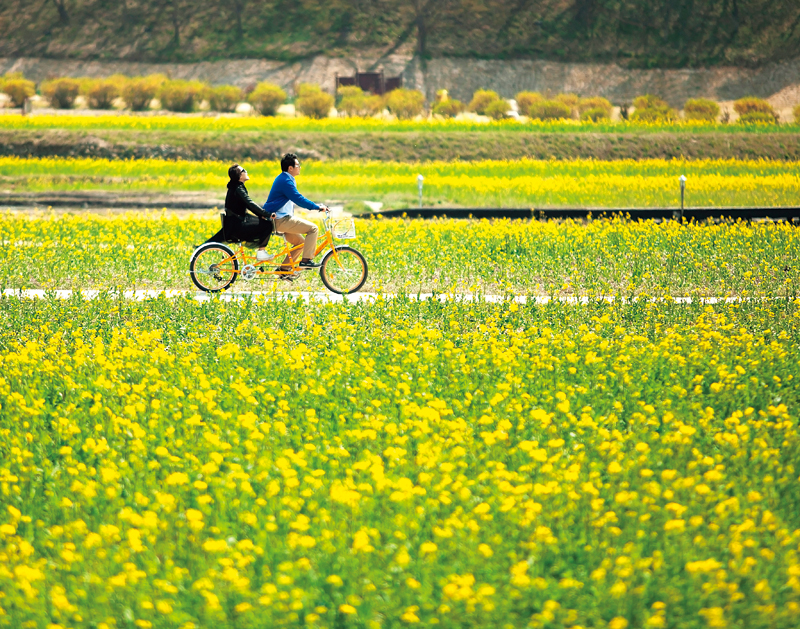
The Wolseong Belt comprises the site of the former royal palace where Silla kings once resided. Today, only parts of the fortress walls and foundations remain. In spring, the area is covered in vibrant canola blossoms, making it a popular destination for young and old.
© Gyeongju City, Photograph by Park Su-yong
HUB OF CONTEMPORARY TRENDS
Hwangnidan-gil occupies a roughly 700-meter stretch of road. Its official name is Poseok-ro, but that is virtually unknown among the crowds who flock every day into the historic area transformed into a tourist destination.
This makeover in the heart of Gyeongju began in the mid-to-late 2010s through a combination of persistent efforts by merchants and support from the city government to revitalize the commercial area. Distinctive shops gradually opened in hanok, rubbing shoulders with buildings constructed during the 1960s and 1970s to create a unique architectural mosaic. During the revitalization, the Hwangnidan-gil moniker emerged in reference to Gyeongnidan-gil in Seoul’s Itaewon neighborhood, a popular haunt for young revelers.
Hwangnidan-gil is an exquisite hybrid of past and present. While the hanok elements might initially remind visitors of the famous traditional village in the city of Jeonju, a stroll along the street reveals a different DNA. The main commercial activity of Hwangnidan-gil tracks along the route of Bus 500, beginning with bakeries and souvenir shops along the wall of Daereungwon. Proceeding all the way to a traditional style hotel named Hwangnamgwan, visitors have an array of choices among remodeled hanok — from snack vendors, cafés, and bakeries to novelty shops and photo studios.
Off the main road are narrow alleyways that spread out like branches and are densely packed with bars, restaurants, fortune-telling cafés, old-world guesthouses, and bookstores. Exploring these winding passages is an enchanting experience. The ambience strongly resembles that of Yufuin village in Kyushu, Japan, or market streets in old European cities, lending itself to unhurried visits. Even something as simple as drinking coffee becomes an event — taking photos for social media is essential, with the actual drinking and eating almost an afterthought.
An abundance of street snacks takes enjoyment of Hwangnidan-gil to an even higher level. The neighborhood is the unquestioned go-to place for all of Gyeongju’s creative desserts and other trendy treats. The most popular item is the palm-sized “ten-won bread” (sibwon ppang), designed to look like the ten-won coin, which features a pagoda from Bulguksa. Another popular item is the “grave-robber bread” (dogul ppang), inspired by Gyeongju’s cultural heritage.
POWERFUL SMALL FESTIVAL
The Hwangnidan-gil area hosts the Golden Carnival, which draws as many as 150,000 people annually. This event, which began in 2022 as the Hwangnam-dong Carnival, was rebranded last year to encompass a wider area. Marketed as a “small neighborhood festival,” it turns local businesses into its main stages. The venues are eclectic, ranging from cafés and restaurants to guesthouses, hair salons, and even parking lots. Due to the intimate nature of these small spaces, attendees can watch performances up close, sometimes close enough to hear the musicians’ breathing.
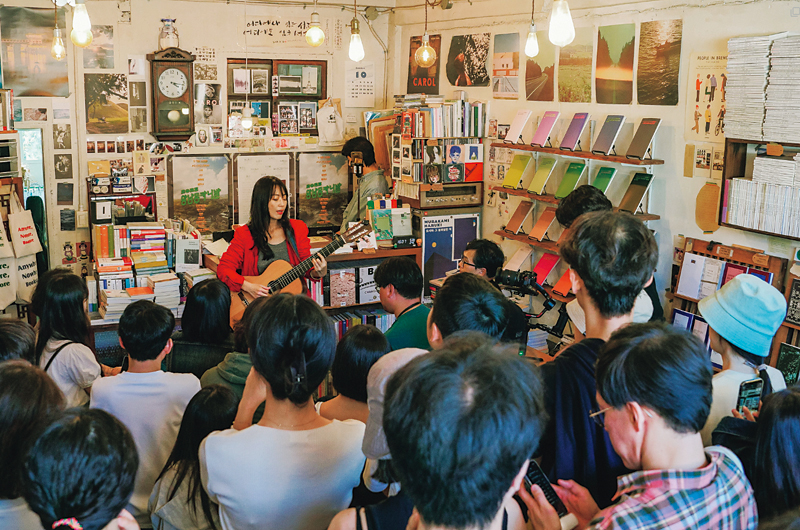
The Golden Carnival is a boutique music festival in Hwangnam-dong featuring Korea’s top indie bands and musicians. Marking its third year in 2024, it has become a popular local festival that brings fresh energy to the commercial district.
© The Golden Carnival
The Golden Carnival is an example of how contemporary music can harmoniously blend with local history. While the stages may be small, the participating musicians are among the biggest acts in South Korea. Last year’s lineup included the Kim Chang Wan Band, JAMBINAI, and CHUDAHYE CHAGIS. Performances by Crying Nut and Galaxy Express, who transformed a serene hanok book café with rock music, were especially popular.
More than just musical performances, the Golden Carnival also offers talks about pop music history, flea markets, and tasting sessions for craft beer from renowned breweries across the country. Most visitors are fascinated that Gyeongju, primarily known as an ancient capital, offers such contemporary experiences.
RIDES FOR THRILLS
These days, Gyeongju World is another major attraction for young visitors. Drawing 1.1 million visitors annually, it is South Korea’s third-largest theme park, following Lotte World in Seoul and Everland in Gyeonggi Province.
Located in the Bomun Tourist Complex, Gyeongju World has evolved significantly over time. For those born in the 1970s and 1980s, it was a place for romantic paddle boat rides during their youth. Many of today’s twenty- or thirty-somethings, however, visit for thrilling, heart-pounding rides. The park’s flagship attraction, Draken, is particularly impressive. This long, serpentine roller coaster is the tallest of its kind in Korea, boasting a vertical drop from as high as a 21-story building. Thrill-seekers flock here from across the country. With a maximum speed reaching 117 km/h and a 90-degree descent angle, the two-minute ride is filled with constant screams.
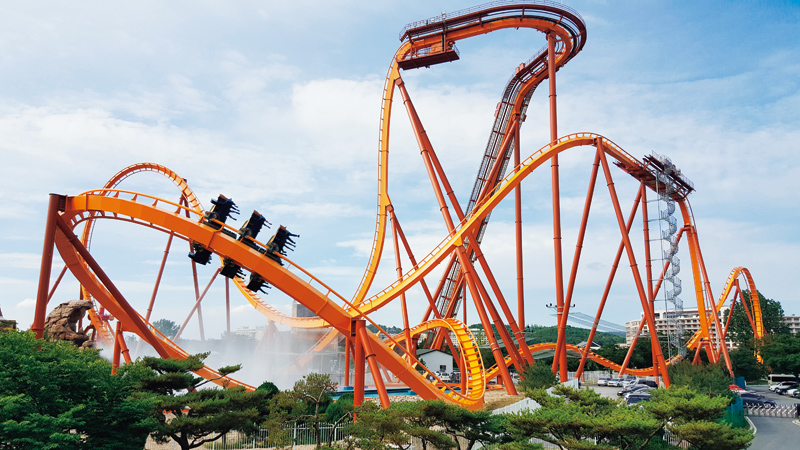
Gyeongju World, situated in the Bomun Tourist Complex, opened in 1985 as Korea’s second amusement park. Its most popular attraction is the Draken roller coaster, which thrills riders with a 90-degree vertical drop from a height of 63 meters.
© Gyeongju World
The inverted Phaethon roller coaster is equally intimidating. In a nationwide survey of the top ten scariest rides in Korea, conducted by Panel Now in 2023, the over 32,000 respondents ranked it fifth, competing with Everland’s T Express and Lotte World’s Gyro Swing.
If thrill-seekers still haven’t had enough after the nosedives, other nerve-wracking attractions await. Klake rotates 360 degrees, suspending riders upside down, and Tornado offers dramatic angle changes and zero-gravity experiences. A recent addition, Sköll & Hati, holds the distinction of being Asia’s first single-rail roller coaster.
About a 15-minute car ride from the Bomun Tourist Complex are popular night viewing spots; Cheomseongdae, as well as Donggung and Wolji, the site of a palace with adjacent pond, are all re-mains of the Silla Kingdom. These locations are consistently bustling with young people seeking to capture perfect nighttime photographs.
BEAUTIFUL MODERN ARCHITECTURE
The Gyeongju Expo Grand Park is the latest addition to the must-see list. Originally established for the 1998 World Culture Expo, it is now a cultural complex offering exhibitions, interactive experiences, and performances.
Young visitors are particularly drawn to the park’s iconic 82-meter-high Gyeongju Tower. Its striking design features a central void, a cut-out in the shape of the seventh-century Nine-Story Wooden Pagoda of Hwangnyongsa, which was burned down by Mongol invaders in 1238. People call the tower “the building that embraces a pagoda.” The concept came from Korean-Japanese architect Itami Jun, who sought to resurrect the lost temple pagoda in contemporary form. The observation deck at the top offers panoramic views of the surrounding landscape, including Gyeongju World and the Bomun Tourist Complex, with Bomun Lake at the center.
Another architectural masterpiece is the Gyeongju International Expo Memorial Hall, the work of renowned Japanese architect Kengo Kuma. The building’s exterior, constructed to resemble stacked basalt, mimics the columnar joints on Gyeongju’s shore. The golden lattice surrounding the entire structure and three hill-like forms symbolize Silla’s famous golden crowns and ancient tombs, respectively. The crown jewel of the Gyeongju Expo Grand Park is the Solgeo Art Museum. It houses approximately 830 works by Park Dae-sung, acclaimed for his contemporary interpretation of traditional ink paintings. Since the visit of RM, the leader of BTS, the museum has become a magnet for ARMY, the global BTS fandom.
During spring, tourists gather at the Pump Track bicycle park. This is not your typical bike park — at 7,800 square meters, it’s the largest in Korea, offering courses for various skill levels. Riders can get their thrills and work on their techniques as they navigate different surfaces. Its greatest appeal? Admission is free. Together with Gyeongju’s historical sites, all these attractions make the city the perfect destination for young and old.
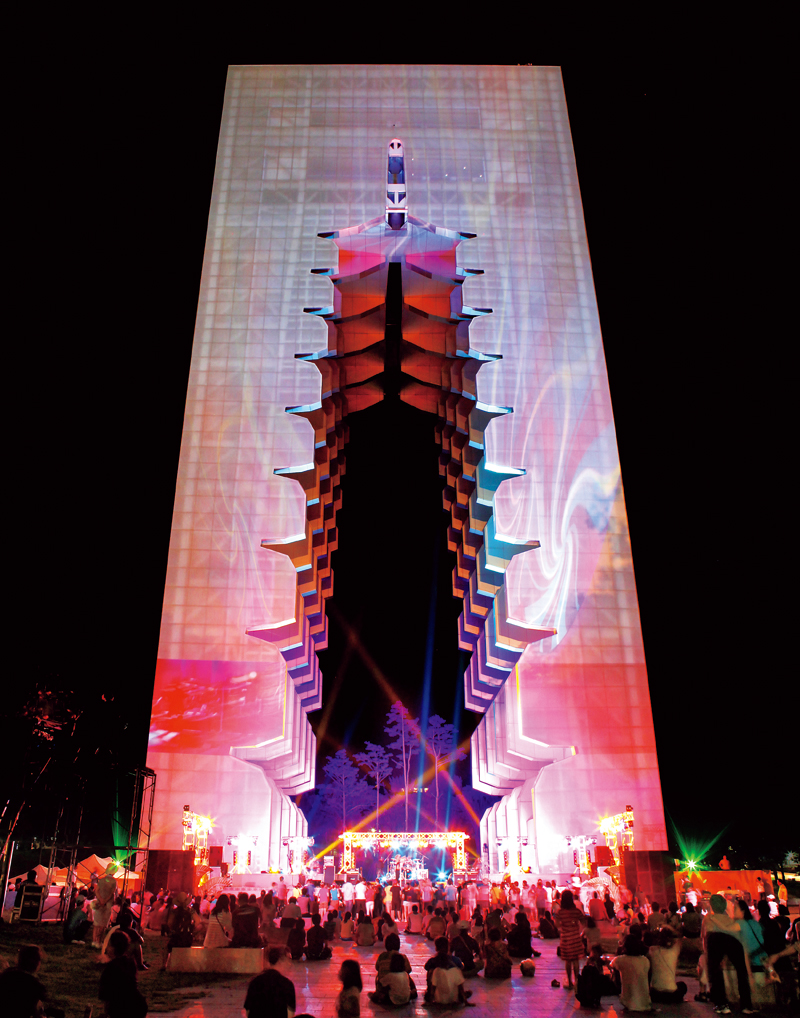
Gyeongju Expo Grand Park, originally an international exposition venue that opened in 1998, has now been transformed into a cultural park with art galleries and museums. Gyeongju Tower within the park is inspired by the Nine-Story Wooden Pagoda of Hwangnyongsa, a significant wooden structure of the Silla Kingdom.
© Gyeongju City, Photograph by Yu Yeong-nim